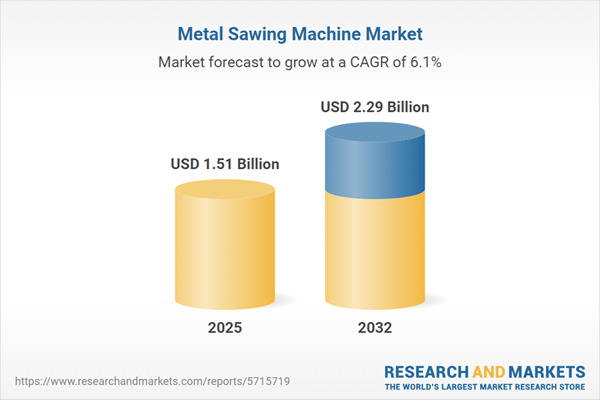Speak directly to the analyst to clarify any post sales queries you may have.
Modern metal sawing machines are reshaping manufacturing by delivering higher precision, enhanced flexibility, and scalable solutions. Senior executives now recognize this technology as foundational for resilient production, particularly in dynamic or volatile industries.
Market Snapshot: Metal Sawing Machine Market Outlook
The global metal sawing machine market is experiencing consistent growth, propelled by rising demand for automation-ready, precision-focused equipment. In 2024, the market reached USD 1.42 billion, with expectations to grow to USD 1.51 billion by 2025 and USD 2.29 billion by 2032, reflecting a 6.10% compound annual growth rate (CAGR). This expansion is strongly tied to the adoption of digital control systems, advanced diagnostic features, and versatile machine frameworks. Vendors are aligning their offerings with manufacturers’ needs for standardized and agile production, especially as supply chain uncertainty elevates the value of robust, automation-compatible platforms at a global scale.
Scope & Segmentation of the Metal Sawing Machine Market
- Saw Types: Abrasive, band, and circular saw models address a wide range of cutting requirements, from mobile use to fixed installations. Both large-scale manufacturers and specialized facilities benefit from these adaptable solutions.
- Material Types: Equipment supports processing of aluminum, copper, stainless steel, carbon steel, and alloy steels, enabling businesses to serve diverse industry segments and tackle specific project needs.
- End User Industries: Aerospace, automotive, construction, energy, and general manufacturing sectors rely on these machines for tailored, high-quality output and consistent compliance with operational standards.
- Operation Modes: Options span CNC automation, PLC-driven controls, as well as semi-automatic and manual systems, each compatible with hydraulic or mechanical drive technology for streamlined integration.
- Power Sources: Machines are available with electric (AC/DC), hydraulic, and pneumatic setups, ensuring operational flexibility and adherence to international machinery standards across production environments.
- Machine Configurations: Handheld, portable, cart-mounted, bench, and floor-mounted formats create options for organizations ranging from agile workshops to high-capacity production lines.
- Blade Materials: Choices such as carbide-tipped, solid carbide, diamond, and high-speed steel blades enable customization of cut quality, speed, and service life to meet specific site goals.
- Regions: Growth is concentrated in the Americas, Europe, Middle East, Africa, and Asia-Pacific, where accelerated technology adoption—especially in markets like China, India, and Southeast Asia—reflects ongoing investment in digitalization and manufacturing performance.
- Leading Companies: Key industry players include KASTO Maschinenbau, HEM SAW, BOMAR, Eisele, DoALL Sawing Products, MEP, KALTENBACH, L.S. Starrett, Imet, and Behringer, all offering full portfolios and robust post-sale service for global clients.
Key Takeaways for Senior Decision-Makers
- Deployment of digital controls and diagnostics supports reliable preventive maintenance and equipment performance, ensuring manufacturing continuity and reducing downtime risks.
- Energy-efficient systems and improved materials handling enable manufacturers to better address regulatory requirements and achieve their sustainability and cost objectives.
- Modular designs make future upgrades or component replacements more manageable, helping organizations keep their technology investments agile amid evolving operational strategies.
- CNC and automated solutions drive throughput efficiencies in demanding production settings, while manual or semi-automatic machines retain necessary flexibility for custom or small-run manufacturing.
- Remote technical support and streamlined logistics for replacement parts promote stable operations even during supply chain interruptions or regulatory changes.
- Robust supplier networks and adaptive sourcing practices reinforce organizational resilience, letting businesses uphold productivity as industry conditions shift.
Tariff Impact: Navigating Regulatory Changes
Forthcoming U.S. tariffs in 2025 are prompting manufacturers to reassess both sourcing and supply strategies for metal sawing machines. As trade environments evolve, enterprises are moving toward nearshoring and more diversified procurement. The focus on close collaboration with suppliers and adoption of value-engineered solutions is intensifying, providing a pathway to sustained output reliability and improved cost management in response to shifting margin pressures.
Methodology & Data Sources
This market intelligence relies on executive interviews, technical expert input, industry comparison studies, and regulatory analysis. Predictive models and structured sector datasets underpin each finding, ensuring senior leaders receive targeted insights relevant to strategic planning.
Why This Report Matters
- Assists executives in prioritizing investments in metal sawing machine technologies, strengthening and future-proofing core manufacturing strategies.
- Equips leadership with actionable segmentation and current trend analysis, enhancing risk management and procurement planning capabilities.
- Enables organizations to efficiently adapt to changes in digitalization and regulatory standards, advancing productivity and competitiveness over the long term.
Conclusion
Metal sawing machines are central to building flexible, reliable production across industries. This report provides senior decision-makers with actionable insights to refine operational planning and maintain agility in a continually changing market environment.
Additional Product Information:
- Purchase of this report includes 1 year online access with quarterly updates.
- This report can be updated on request. Please contact our Customer Experience team using the Ask a Question widget on our website.
Table of Contents
3. Executive Summary
4. Market Overview
7. Cumulative Impact of Artificial Intelligence 2025
Companies Mentioned
The companies profiled in this Metal Sawing Machine market report include:- KASTO Maschinenbau GmbH & Co. KG
- HEM SAW Co., Ltd.
- BOMAR spol. s r.o.
- Eisele GmbH & Co. KG
- DoALL Sawing Products (W.R. Deutschendorf Inc.)
- MEP S.p.A.
- KALTENBACH GmbH & Co. KG
- L.S. Starrett Company
- Imet S.p.A.
- Behringer GmbH
Table Information
| Report Attribute | Details |
|---|---|
| No. of Pages | 187 |
| Published | October 2025 |
| Forecast Period | 2025 - 2032 |
| Estimated Market Value ( USD | $ 1.51 Billion |
| Forecasted Market Value ( USD | $ 2.29 Billion |
| Compound Annual Growth Rate | 6.1% |
| Regions Covered | Global |
| No. of Companies Mentioned | 11 |









